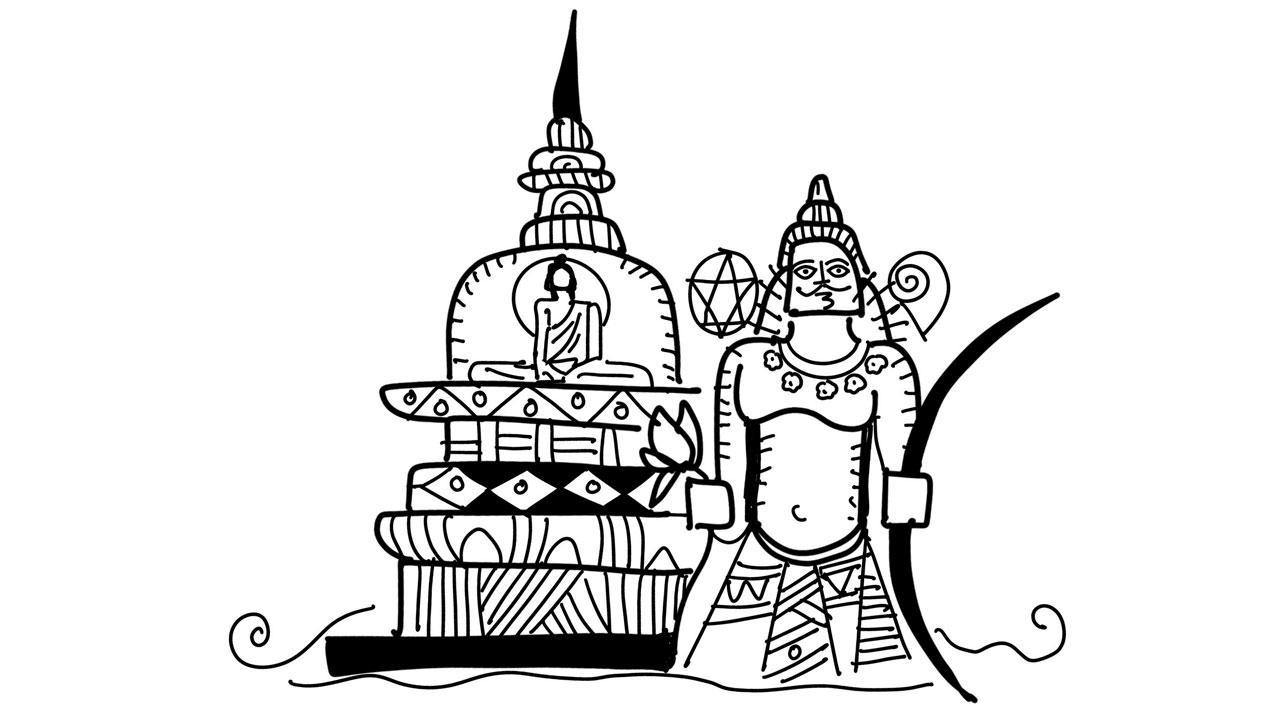From there, the Theravada school of Buddhism travelled to Southeast Asia

Illustration/Devdutt Pattanaik
 Many Hindus argue that the ninth avatar of Vishnu is Buddha. But hardly any Hindus know about how Vishnu is a guardian-god in the Buddhist faith in Sri Lanka. As per Buddhist mythology, many Buddhas including Gautama Buddha have visited Sri Lanka in the past. This makes Sri Lanka an important centre of Buddha-shasan (Buddhist culture). From there, the Theravada school of Buddhism travelled to Southeast Asia.
Many Hindus argue that the ninth avatar of Vishnu is Buddha. But hardly any Hindus know about how Vishnu is a guardian-god in the Buddhist faith in Sri Lanka. As per Buddhist mythology, many Buddhas including Gautama Buddha have visited Sri Lanka in the past. This makes Sri Lanka an important centre of Buddha-shasan (Buddhist culture). From there, the Theravada school of Buddhism travelled to Southeast Asia.
ADVERTISEMENT
In Sri Lanka, Gautama Buddha is the primary source of dhamma, and provides liberation (nibbana) to all beings. His culture is defended by four beings: Natha, Pattini, Kataragama and Vishnu. These guardians satisfy the material needs of local people—providing protection from diseases and demons, and bestowing prosperity. These guardians belong to rival faiths and by making them part of, but subservient to, Buddhism, peace was maintained in Sri Lanka between diverse communities. It is said that these guardians will be Buddhas in the future.
Natha Deva is linked to Avalokiteshwar, the chief Bodhisattva of Mahayana Buddhism, that once flourished in Sri Lanka but was eventually overshadowed by Theravada Buddhism. Pattini is from the Shakti cult of Hinduism, a folk deity, the chaste wife whose fidelity for her husband granted her magical powers. Her story is told in the famous Tamil classic, Silappadikaram. Kataragama is the local form of the Tamil god Murugan, thus from Shaivite traditions. From the Vaishnav tradition comes Vishnu Devale, who is an amalgamation of a local god, Upulvan, the Hindu god Vishnu, and his avatars, Ram and Krishna. He uses his “golden bow” with which he drives away Mara, the demon of desire, who is the eternal enemy of the Buddha.
Upalvan was an ancient Sri Lankan folk god who is mentioned in the most ancient Sri Lankan lore. He welcomed Vijaya who migrated to Sri Lanka from India 2,500 years ago. Eventually, Upalvan’s worship merged with the idea of Vishnu since both were gods who were as blue as the blue lily. This Buddhist Vishnu is linked to the Ocean of Milk, from where he raised the earth like Varaha, the mighty boar. He churned that ocean to get the golden bow, with which he cured his sister from the disease inflicted on her by the vengeful Mara. Within the ocean, he planted the lotus on whose petals were the robes that were given to different Buddhas of different eras. Alluding to Krishna, he once found seven goddesses bathing in a pond and fell in love with one of them, whose clothes he stole, compelling her to be his consort. Her name was Sita. Like the Hindu Vishnu, he is known to be wily and wise, but unlike the Hindu Vishnu, he is not a sensual or sexual being. This reveals the strong Buddhist influence.
In images, Upalvan-Vishnu looks much like the Hindu Vishnu with four arms bearing the disc, the conch, the wheel and the mace. Often, the mace is replaced with his golden bow. As part of the ceremony, “sandesha” or message hymns are sent to him to grant protection to those who protect Buddhism in the island kingdom. Stories of Buddha in Hindu mythology and Vishnu in Buddhist mythology explain how Hindus of India pushed out Buddhism, while Buddhists of Sri Lanka kept Hinduism at bay.
The author writes and lectures on the relevance of mythology in modern times. Reach him at devdutt.pattanaik@mid-day.com
 Subscribe today by clicking the link and stay updated with the latest news!" Click here!
Subscribe today by clicking the link and stay updated with the latest news!" Click here!







